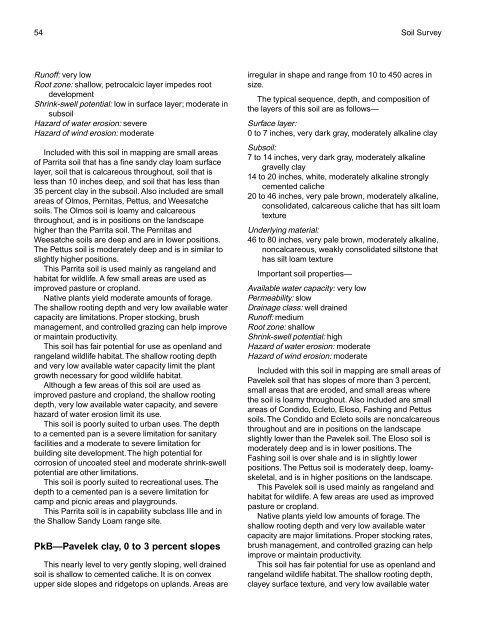Soil Survey of Karnes County, Texas - Soil Data Mart - US ...
Soil Survey of Karnes County, Texas - Soil Data Mart - US ...
Soil Survey of Karnes County, Texas - Soil Data Mart - US ...
Create successful ePaper yourself
Turn your PDF publications into a flip-book with our unique Google optimized e-Paper software.
54 <strong>Soil</strong> <strong>Survey</strong><br />
Run<strong>of</strong>f: very low<br />
Root zone: shallow, petrocalcic layer impedes root<br />
development<br />
Shrink-swell potential: low in surface layer; moderate in<br />
subsoil<br />
Hazard <strong>of</strong> water erosion: severe<br />
Hazard <strong>of</strong> wind erosion: moderate<br />
Included with this soil in mapping are small areas<br />
<strong>of</strong> Parrita soil that has a fine sandy clay loam surface<br />
layer, soil that is calcareous throughout, soil that is<br />
less than 10 inches deep, and soil that has less than<br />
35 percent clay in the subsoil. Also included are small<br />
areas <strong>of</strong> Olmos, Pernitas, Pettus, and Weesatche<br />
soils. The Olmos soil is loamy and calcareous<br />
throughout, and is in positions on the landscape<br />
higher than the Parrita soil. The Pernitas and<br />
Weesatche soils are deep and are in lower positions.<br />
The Pettus soil is moderately deep and is in similar to<br />
slightly higher positions.<br />
This Parrita soil is used mainly as rangeland and<br />
habitat for wildlife. A few small areas are used as<br />
improved pasture or cropland.<br />
Native plants yield moderate amounts <strong>of</strong> forage.<br />
The shallow rooting depth and very low available water<br />
capacity are limitations. Proper stocking, brush<br />
management, and controlled grazing can help improve<br />
or maintain productivity.<br />
This soil has fair potential for use as openland and<br />
rangeland wildlife habitat. The shallow rooting depth<br />
and very low available water capacity limit the plant<br />
growth necessary for good wildlife habitat.<br />
Although a few areas <strong>of</strong> this soil are used as<br />
improved pasture and cropland, the shallow rooting<br />
depth, very low available water capacity, and severe<br />
hazard <strong>of</strong> water erosion limit its use.<br />
This soil is poorly suited to urban uses. The depth<br />
to a cemented pan is a severe limitation for sanitary<br />
facilities and a moderate to severe limitation for<br />
building site development. The high potential for<br />
corrosion <strong>of</strong> uncoated steel and moderate shrink-swell<br />
potential are other limitations.<br />
This soil is poorly suited to recreational uses. The<br />
depth to a cemented pan is a severe limitation for<br />
camp and picnic areas and playgrounds.<br />
This Parrita soil is in capability subclass IIIe and in<br />
the Shallow Sandy Loam range site.<br />
PkB—Pavelek clay, 0 to 3 percent slopes<br />
This nearly level to very gently sloping, well drained<br />
soil is shallow to cemented caliche. It is on convex<br />
upper side slopes and ridgetops on uplands. Areas are<br />
irregular in shape and range from 10 to 450 acres in<br />
size.<br />
The typical sequence, depth, and composition <strong>of</strong><br />
the layers <strong>of</strong> this soil are as follows—<br />
Surface layer:<br />
0 to 7 inches, very dark gray, moderately alkaline clay<br />
Subsoil:<br />
7 to 14 inches, very dark gray, moderately alkaline<br />
gravelly clay<br />
14 to 20 inches, white, moderately alkaline strongly<br />
cemented caliche<br />
20 to 46 inches, very pale brown, moderately alkaline,<br />
consolidated, calcareous caliche that has silt loam<br />
texture<br />
Underlying material:<br />
46 to 80 inches, very pale brown, moderately alkaline,<br />
noncalcareous, weakly consolidated siltstone that<br />
has silt loam texture<br />
Important soil properties—<br />
Available water capacity: very low<br />
Permeability: slow<br />
Drainage class: well drained<br />
Run<strong>of</strong>f: medium<br />
Root zone: shallow<br />
Shrink-swell potential: high<br />
Hazard <strong>of</strong> water erosion: moderate<br />
Hazard <strong>of</strong> wind erosion: moderate<br />
Included with this soil in mapping are small areas <strong>of</strong><br />
Pavelek soil that has slopes <strong>of</strong> more than 3 percent,<br />
small areas that are eroded, and small areas where<br />
the soil is loamy throughout. Also included are small<br />
areas <strong>of</strong> Condido, Ecleto, Eloso, Fashing and Pettus<br />
soils. The Condido and Ecleto soils are noncalcareous<br />
throughout and are in positions on the landscape<br />
slightly lower than the Pavelek soil. The Eloso soil is<br />
moderately deep and is in lower positions. The<br />
Fashing soil is over shale and is in slightly lower<br />
positions. The Pettus soil is moderately deep, loamyskeletal,<br />
and is in higher positions on the landscape.<br />
This Pavelek soil is used mainly as rangeland and<br />
habitat for wildlife. A few areas are used as improved<br />
pasture or cropland.<br />
Native plants yield low amounts <strong>of</strong> forage. The<br />
shallow rooting depth and very low available water<br />
capacity are major limitations. Proper stocking rates,<br />
brush management, and controlled grazing can help<br />
improve or maintain productivity.<br />
This soil has fair potential for use as openland and<br />
rangeland wildlife habitat. The shallow rooting depth,<br />
clayey surface texture, and very low available water
















